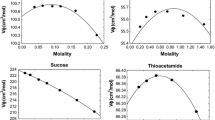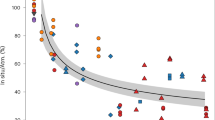Abstract
Using a pressurized temperature gradient, which rapidly equilibrates bacteria to a wide range of temperature and pressures, temperature ranges for growth and survival of Vibrio harveyi (strain B 392) were found to narrow with increasing pressures. Both temperature and pressure ranges were greater in an enriched seawater medium than in unenriched seawater. Using a kinetics apparatus, V. harveyi was also exposed to gradual changes in temperature and pressure, simulating a particle sinking at approximately 200 m d-1 from surface waters (17 °C; ∼1 bar pressure) to 3 400 m (∼4°C; 340 bars pressure). With gradual temperature changes, cells were able to grow and survive at lower temperatures than they had in rapid equilibration experiments. Gradual pressurization, however, did not increase pressure tolerance. Under all experimental conditions, the combined effects of low temperatures and high pressures were lethal for V. harveyi. It is hypothesized that temperature and pressure stratify the ocean into regions of growth, survival, and death for V. harveyi, and perhaps other bacteria.
Similar content being viewed by others
Literature cited
Baross, J. A., F. J. Hanus and R. Y. Morita: The survival of human enteric and other sewage microorganisms under simulated deep-sea conditions. Appl. Microbiol. 21, 309–318 (1975)
Baross, J. A. and R. Y. Morita: Microbial life at low temperatures, ecological aspects. In: Microbial life in extreme environments, pp 9–71. Ed. by D. J. Kushner. New York: Academic Press 1978
Bell, C. R. and L. J. Albright: Attached and free-floating bacteria in a diverse selection of water bodies. Appl. environ. Microbiol. 43, 1227–1237 (1982)
CalCOFl Special Basin Cruise: Physical and chemical data, cruise 7007, Scripps Inst. Oceanogr., SIO Ref. Ser. 79-30, 56 (1969–1971)
Caron, D. A., P. G. Davis L. P. Madin and J. McN. Sieburth: Heterotrophic bacteria and bacterivorous protozoa in oceanic macroaggregates. Science, Wash., D.C. 218, 795–797 (1982)
Harris, N. D.: The influence of the recovery medium and the incubation temperature on the survival of damaged bacteria. J. appl. Bact. 26, 387–397 (1963)
Jannasch, H. W.: Microbial ecology of aquatic low nutrient habitats. In: Strategies of microbial life in extreme environments, pp 243–260. Ed. by M. Shilo. New York: Verlag Chemie 1979
Jannasch, H. W. and C. O. Wirsen: Variability of pressure adaptation in deep sea bacteria. Arch. Microbiol. 139, 281–288 (1984)
Johnson, F. H., H. Eyring and B. J. Stover: The theory of rate processes in biology and medicine, 701 pp. New York: John Wiley & Sons 1973
Joint, I. R. and R. J. Morris: The role of bacteria in the turnover of organic matter in the sea. Oceanogr. Mar. Biol. A. Rev. 20, 65–118 (1982)
Lal, D.: The oceanic microcosm of particles. Science, Wash. D.C. 198, 997–1009 (1977)
MacLeod, R. A. and P. H. Calcott: Cold shock and freezing damage to microbes. In: The survival of vegetative microbes, pp 81–109. Ed. by T. R. G. Gray and J. R. Postgate. New York: Cambridge Univ. Press 1976
Marquis, R. E.: Reversible actions of hydrostatic pressure and compressed gases on microorganisms. In: Repairable lesions in microorganisms, pp 273–301. Ed. by A. Hust New York: Academic Press 1984
Marshall, K. C.: Growth at interfaces. In: Strategies of microbial life in extreme environments, pp 281–290. Ed. by M. Shilo, New York: Verlag Chemie 1979
Martin, P. and R. A. MacLeod: Observations on the distinction between oligotrophic and eutrophic marine bacteria. Appl. environ. Microbiol. 47, 1017–1022 (1984)
Matsumura, P. and R. E. Marquis: Energetics of Streptococcal growth inhibition by hydrostatic pressure. Appl. environ. Microbiol. 33, 885–892 (1977)
Morita, R. Y.: Survival of bacteria in cold and moderate hydrostatic pressure environments with special reference to psychrophilic and barophilic bacteria. In: The survival of vegetative microbes, pp 279–298. Ed. by T. R. G. Gray and J. R. Postgate. New York: Cambridge Univ. Press 1976
Nealson K. H.: Isolation, identification and manipulation of luminous bacteria. Methods Enzymol. 57, 153–166 (1978)
Novitsky, J. A. and R. Y. Morita: Starvation-induced barotolerance as a survival mechanism of a psychorophilic marine vibrio in the waters of the antarctic convergence. Mar. Biol. 49, 7–10 (1978)
Paerl, H. W.: Microbial attachment to particles in marine and freshwater ecosystems. Microb. Ecol. 2, 73–83 (1975)
Postgate, J. R.: Death in macrobes and microbes. In: The survival of vegetative microbes, pp 1–18. Ed. by T. R. G. Gray and J. R. Postgate, New York: Cambridge Univ. Press 1976
Postgate, J. R. and J. R. Hunter: The survival of starved bacteria. J. gen. Microbiol. 29, 233–263 (1962)
Ruby, E. G. and K. H. Nealson: Seasonal changes in the species composition of luminous bacteria in near-shore seawater. Limnol. Oceanogr. 23, 530–533 (1978)
Ruby, E. G., E. P. Greenberg and J. W. Hastings: Planktonic marine luminous bacteria: species distribution in the water column. Appl. environ. Microbiol. 39, 302–306 (1980)
Sato, M. and H. Takahashi: Cold shock of bacteria. I. General features of cold shock in Escherichia coli. J. gen appl. Microbiol. 14, 417–428 (1968)
Sato, M. and H. Takahashi: Cold shock of bacteria. II. Magnesium-mediated recovery from cold shock and existence of two critical temperature zones in various bacteria. J. gen. appl. Microbiol. 15, 217–229 (1969)
Sato, M. and H. Takahashi: Cold shock of bacteria. IV. Involvement of DNA ligase reaction in recovery of Escherichia coli from cold shock. J. gen. appl. Microbiol. 16 279–290 (1970)
Shaw, M. K.: Effect of abrupt temperature shift on the growth of mesophilic and psychrophilic yeasts. J. Bact. 93, 1332–1336 (1967)
Shilo, M. and T. Yetinson: Physiological characteristics underlying the distribution patterns of luminous bacteria in the Mediterranean Sea and the Gulf of Elat. Appl. environ. Microbiol. 38, 577–584 (1979)
Sieburth, J. McN.: Seasonal selection of estuarine bacteria by water temperature. J. exp. mar. Biol. Ecol. 1, 98–121 (1967)
Smayda, T. J.: The suspension and sinking of phytoplankton in the sea. A. Rev. Oceanogr. mar. Biol. 8, 353–414 (1970)
Strange, R. E. and M. Shon: Effects of thermal stress on viability and ribonucleic acid of Aerobacter aerogenes in aqueous suspension. J. gen Microbiol. 34, 99–114 (1964)
Tabor, P. S., J. W. Deming, K. Ohwada, H. Davis, M. Waxman and R. R. Colwell: A pressure-retaining deep ocean sampler and transfer system for measurement of microbial activity in the deep sea. Microb. Ecol. 7, 51–65 (1981)
Wiebe, W. J. and L. R. Pomeroy: Microorganisms and their association with aggregates and detritus in the sea: a microscopic study. Mem. Ist. Ital. Idrobiol. Dott Marco de Marchi Pallanza Italy 29 (Suppl.), 325–352 (1972)
Yayanos, A. A.: A technique for studying biological reaction rates at high pressure. Rev. Sci. Instrum. 40, 961–963 (1969)
Yayanos, A. A., R. Van Boxtel and A. S. Dietz: Reproduction of Bacillus stearothermophilus as a function of temperature and pressure. Appl. environ. Microbiol. 46, 1357–1363 (1983)
Yayanos, A. A., R. Van Boxtel and A. S. Dietz: High-pressure-temperature gradient instrument: use for determining the temperature and pressure limits of bacterial growth. Appl. environ. Microbiol. 48, 771–776 (1984)
yetinson, T. and M. Shilo: Seasonal and geographical distribution of luminous bacteria in the eastern Mediterranean Sea and the Gulf of Elat. Appl. environ Microbiol. 37, 1230–1238 (1979)
ZoBell, C. E.: Pressure effects on morphology and life processes of bacteria. In: High pressure effects on cellular processes, pp 85–130. Ed. by A. M. Zimmerman. New York: Academic Press 1970
ZoBell C. E.: Substratum; bacteria, fungi and blue-green algae. In: Marine ecology, Vol. 1, pp 1251–1289. Ed. by O. Kinne. New York: Wiley-Interscience 1972
ZoBell, C. E. and F. H. Johnson: The influence of hydrostatic pressure on the growth and viability of terrestrial and marine bacteria. J. Bacteriol. 57, 179–189 (1949)
ZoBell, C. E. and R. Y. Morita: Deep-sea bacteria. Galathea Rep. 1, 139–154 (1957)
ZoBell, C. E. and C. H. Oppenheimer: Some effects of hydrostatic pressure on the multiplication and morphology of marine bacteria. J. Bacteriol. 60, 771–781 (1950)
Author information
Authors and Affiliations
Additional information
Communicated by J. M. Lawrence, Tampa
Rights and permissions
About this article
Cite this article
Trent, J.D., Yayanos, A.A. Pressure effects on the temperature range for growth and survival of the marine bacterium Vibrio harveyi: Implications for bacteria attached to sinking particles. Mar. Biol. 89, 165–172 (1985). https://doi.org/10.1007/BF00392887
Accepted:
Issue Date:
DOI: https://doi.org/10.1007/BF00392887




